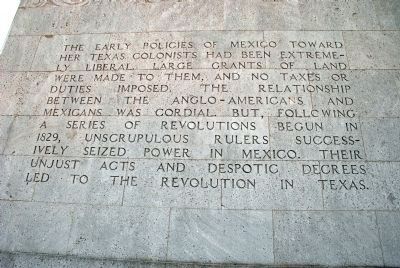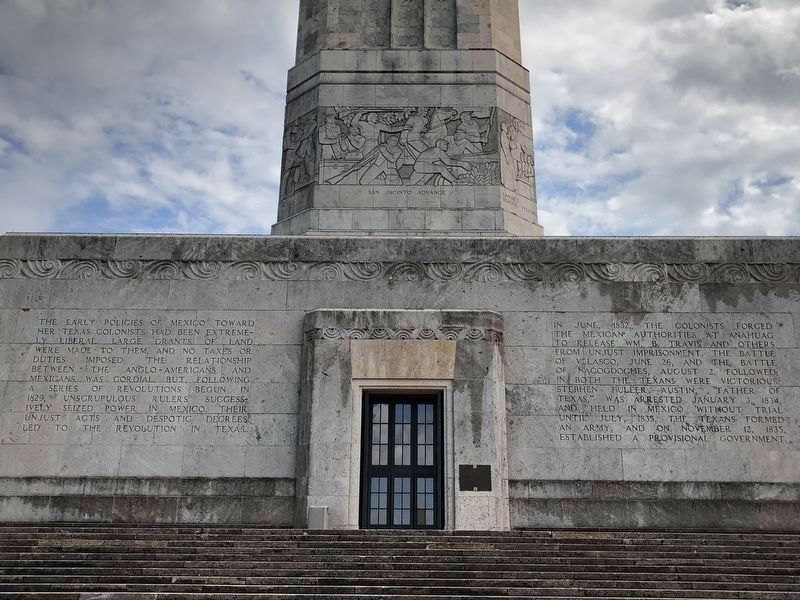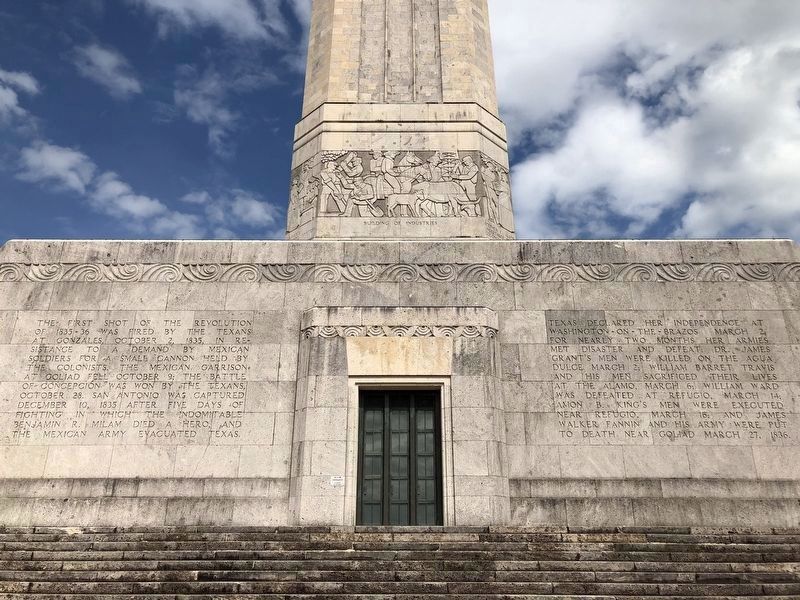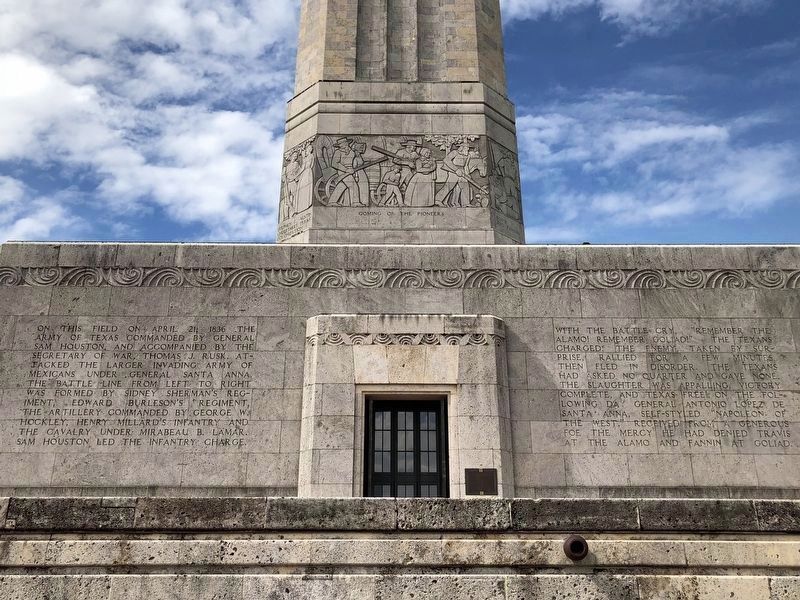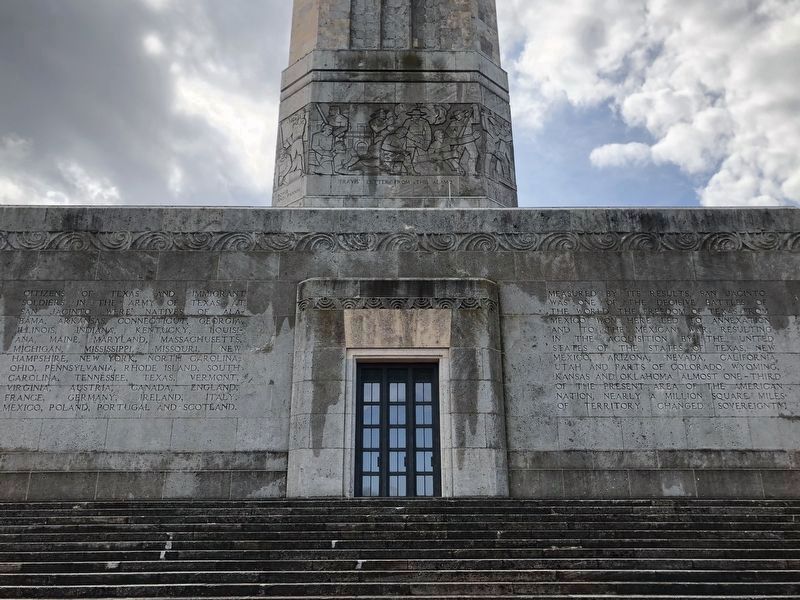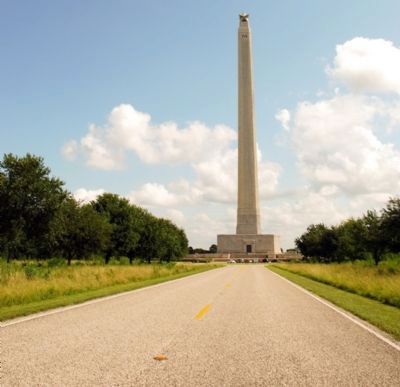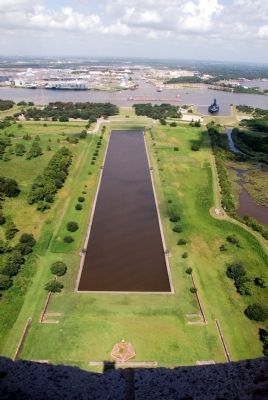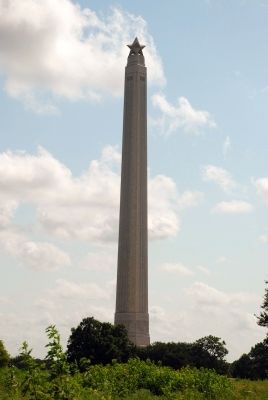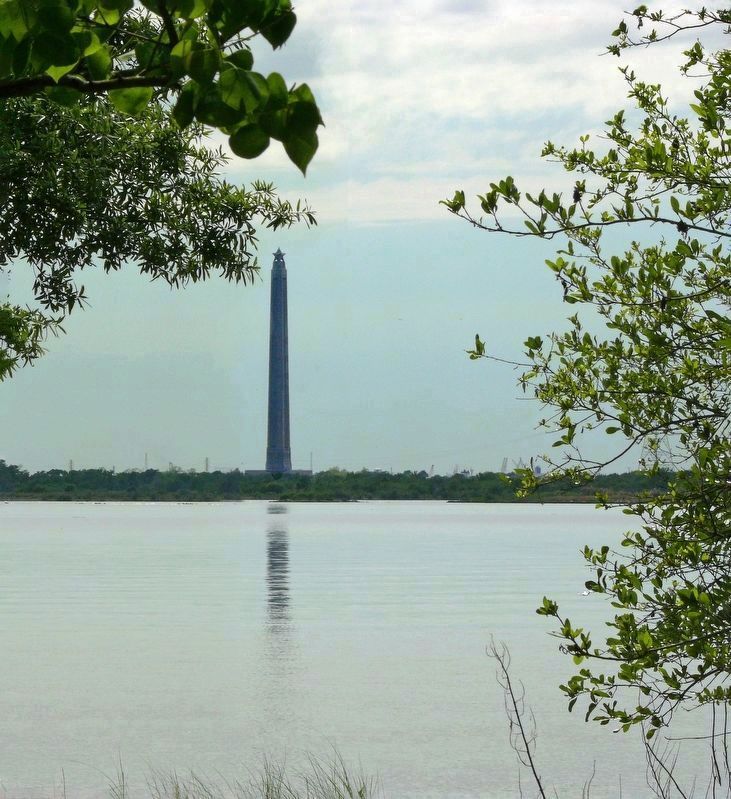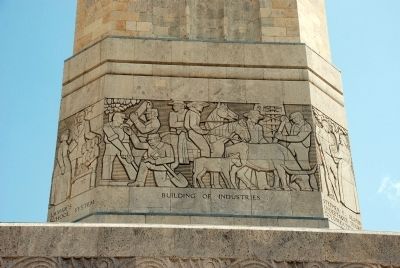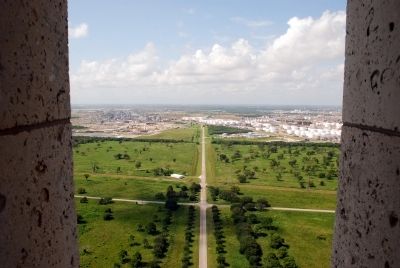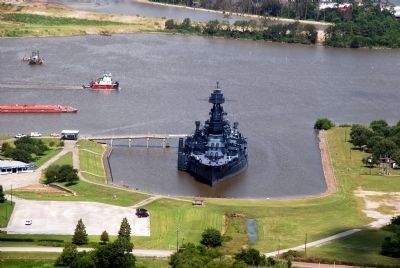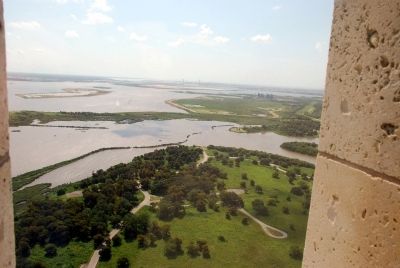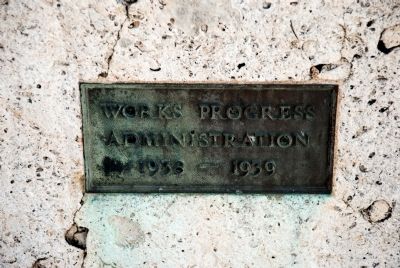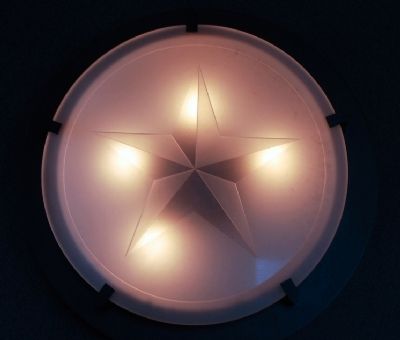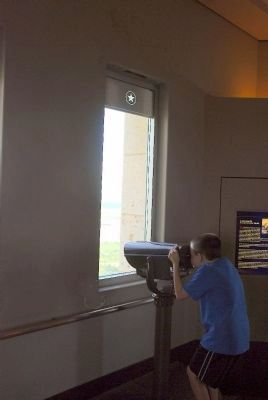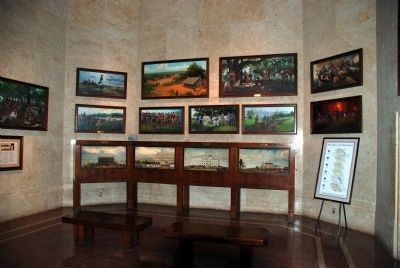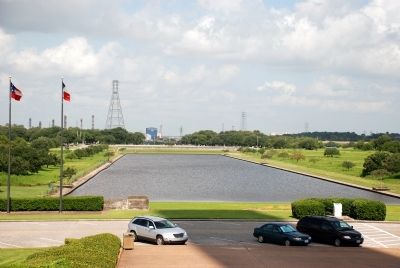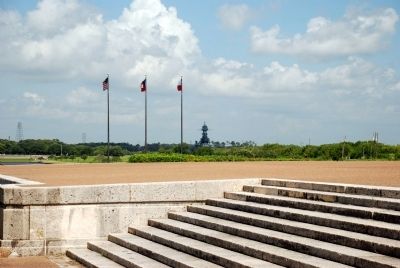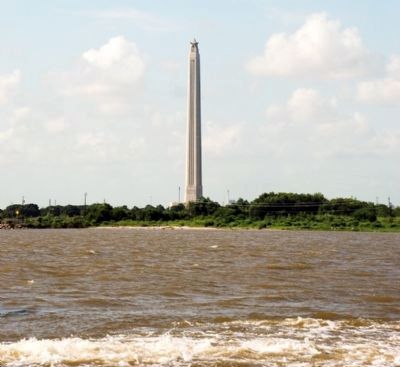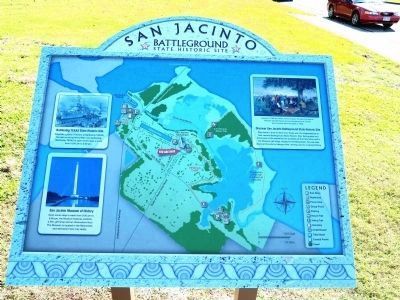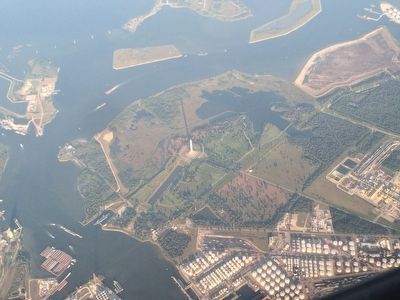Shoreacres in La Porte in Harris County, Texas — The American South (West South Central)
San Jacinto Monument
San Jacinto Battlefield
Inscription.
The early policies of Mexico toward her Texas colonists had been extremely liberal. Large grants of land were made to them, and no taxes or duties imposed. The relationship between the Anglo-Americans and Mexicans was cordial. But, following a series of revolutions begun in 1829, unscrupulous rulers successively seized power in Mexico. Their unjust acts and despotic decrees led to the revolution in Texas.
In June, 1832, the colonists forced the Mexican authorities at Anahuac to release Wm. B. Travis and others from unjust imprisonment. The Battle of Velasco, June 26, and the Battle of Nacogdoches, August 2, followed; in both the Texans were victorious. Stephen Fuller Austin, "Father of Texas," was arrested January 3, 1834, and held in Mexico without trial until July, 1835. The Texans formed an army, and on November 12, 1835, established a provisional government.
The first shot of the Revolution of 1835-36 was fired by the Texans at Gonzales, October 2, 1835, in resistance to a demand by Mexican soldiers for a small cannon held by the colonists. The Mexican garrison at Goliad fell October 9; the Battle of Concepcion was won by the Texans, October 28. San Antonio was captured December 10, 1835 after five days of fighting in which the indomitable Benjamin R. Milam died a hero, and the Mexican Army evacuated Texas.
Texas declared her independence at Washington-on-the-Brazos March 2. For nearly two months her armies met disaster and defeat: Dr. James Grant's men were killed on the Aguadulce March 2; William Barret Travis and his men sacrificed their lives at the Alamo, March 6; William Ward was defeated at Refugio, March 14; Amos B. King's men were executed near Refugio, March 16; and James Walker Fannin and his army were put to death near Goliad March 27, 1836.
On this field on April 21, 1836 the Army of Texas commanded by General Sam Houston, and accompanied by the Secretary of War, Thomas J. Rusk, attacked the larger invading army of Mexicans under General Santa Anna. The battle line from left to right was formed by Sidney Sherman's regiment, Edward Burleson's regiment, the artillery commanded by George W. Hockley, Henry Millard's infantry and the cavalry under Mirabeau B. Lamar. Sam Houston led the infantry charge.
With the battle cry, "Remember the Alamo! Remember Goliad!" the Texans charged. The enemy taken by surprise, rallied for a few minutes then fled in disorder. The Texans had asked no quarter and gave none. The slaughter was appalling, victory complete, and Texas free! On the following day General Antonio Lopez De Santa Anna, self-styled "Napoleon of the West," received from a generous foe the mercy he had denied Travis at the Alamo and Fannin at Goliad.
Citizens of Texas and immigrant soldiers in the Army of Texas at San Jacinto were natives of Alabama, Arkansas, Connecticut, Georgia, Illinois, Indiana, Kentucky, Louisiana, Maine, Maryland, Massachusetts, Michigan, Mississippi, Missouri, New Hampshire, New York, North Carolina, Ohio, Pennsylvania, Rhode Island, South Carolina, Tennessee, Texas, Vermont, Virginia, Austria, Canada, England, France, Germany, Ireland, Italy, Mexico, Poland, Portugal and Scotland.
Measured by its results, San Jacinto was one of the decisive battles of the world. The freedom of Texas from Mexico won here led to annexation and to the Mexican-American War, resulting in the acquisition by the United States of the states of Texas, New Mexico, Arizona, Nevada, California, Utah and parts of Colorado, Wyoming, Kansas and Oklahoma. Almost one-third of the present area of the American Nation, nearly a million square miles of territory, changed sovereignty.
Erected 1939 by State of Texas.
Topics and series. This historical marker and monument is listed in this topic list: War, Texas Independence. In addition, it is included in the Art Deco, and the National Historic Landmarks series lists. A significant historical date for this entry is January 3, 1862.
Location. 29° 44.994′ N, 95° 4.848′ W. Marker is in La Porte, Texas, in Harris County. It is in Shoreacres. Marker is on One Monument Circle. Touch for map. Marker is in this post office area: La Porte TX 77571, United States of America. Touch for directions.
Other nearby markers. At least 8 other markers are within walking distance of this marker. Sherman's Advance (about 500 feet away, measured in a direct line); Houston Wounded (approx. 0.2 miles away); Mexican Breastworks (approx. ¼ mile away); Mexican Cannon (approx. ¼ mile away); Mexican Position (approx. ¼ mile away); Santa Anna's Camp (approx. 0.3 miles away); a different marker also named Mexican Breastworks (approx. 0.3 miles away); Cavalry Skirmish (approx. 0.4 miles away). Touch for a list and map of all markers in La Porte.
Regarding San Jacinto Monument. The monument is a 570 foot high column dedicated to the Texas War for Independence from Mexico. It is the world's tallest masonry tower (taller than the Washington Monument) and is constructed of Texas Limestone. At the top, there is a 34-foot Lone Star, an example of Art Deco architecture, certainly the largest in the United States.
Also see . . .
1. Story of the San Jacinto Monument. "In future time, then may the pilgrim's eye see here an obelisk point toward the sky...."— Anonymous poet (Submitted on March 28, 2008, by Craig Swain of Leesburg, Virginia.)
2. Wikipedia San Jacinto Monument Entry. (Submitted on March 28, 2008, by Ronald Claiborne of College Station, Texas.)
3. 2009 Roger Moore on San Jacinto Archeology and Q&A session. Video published by San Jacinto Battleground Conservancy (Submitted on November 3, 2014, by Richard Denney of Austin, Texas.)
4. San Jacinto, Battle of - The Handbook of Texas Online. Texas State Historical Association (TSHA) (Submitted on November 13, 2018, by Brian Anderson of Humble, Texas.)
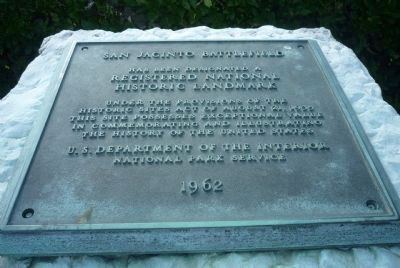
Photographed By Richard E. Miller, August 15, 2010
21. San Jacinto Battlefield has been named a Registered National Historical Landmark
U.S. Department of the Interior
National Park Service
1962
Credits. This page was last revised on February 1, 2023. It was originally submitted on March 28, 2008, by Ronald Claiborne of College Station, Texas. This page has been viewed 8,150 times since then and 72 times this year. It was the Marker of the Week April 21, 2013. Photos: 1. submitted on March 28, 2008, by Ronald Claiborne of College Station, Texas. 2, 3, 4. submitted on November 13, 2018, by Brian Anderson of Humble, Texas. 5. submitted on November 29, 2018, by Brian Anderson of Humble, Texas. 6, 7, 8. submitted on March 28, 2008, by Ronald Claiborne of College Station, Texas. 9. submitted on April 5, 2020, by Jim Evans of Houston, Texas. 10, 11, 12, 13, 14, 15, 16, 17, 18, 19, 20. submitted on March 28, 2008, by Ronald Claiborne of College Station, Texas. 21. submitted on October 7, 2010, by Richard E. Miller of Oxon Hill, Maryland. 22, 23. submitted on November 3, 2014, by Richard Denney of Austin, Texas. 24. submitted on October 23, 2015, by J. Makali Bruton of Accra, Ghana. • Craig Swain was the editor who published this page.
